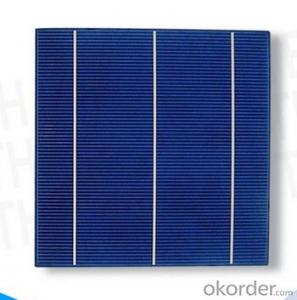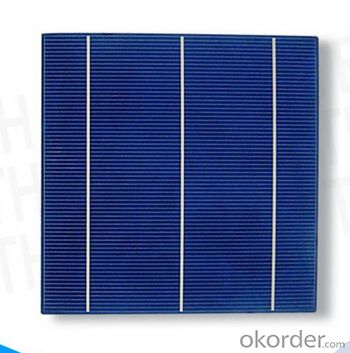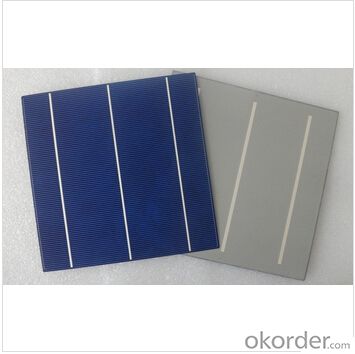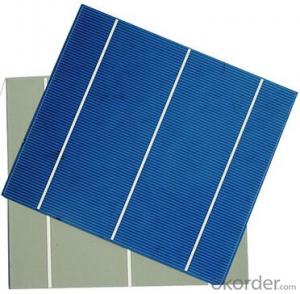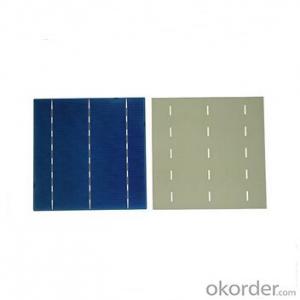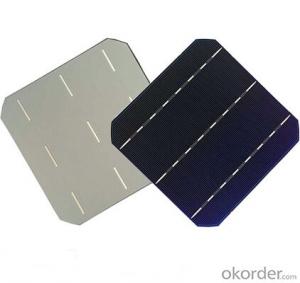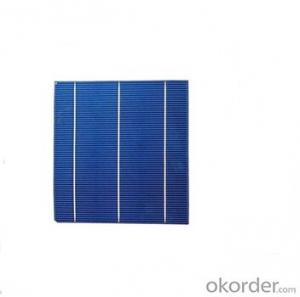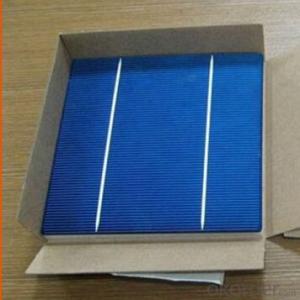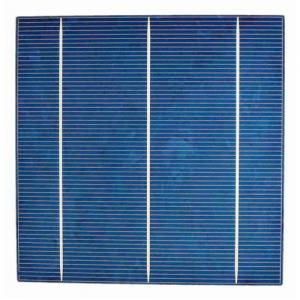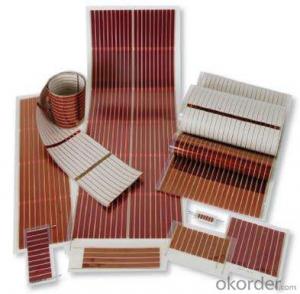High Quality Floating Polycrystalline Solar Cells 17.00-17.19effy
- Loading Port:
- Shanghai
- Payment Terms:
- TT or LC
- Min Order Qty:
- 1000 pc
- Supply Capability:
- 1000000 pc/month
OKorder Service Pledge
OKorder Financial Service
You Might Also Like
Solar Cells:
solar cells, when struck by photons of light from the sun, generates an electrical current which can then be used to power DC or AC electrical loads.
A solar cell is made of silicon. Computer chips are made of this same material. Basically, when light strikes the surface of a solar cell some of it is absorbed into the silicon. This light energy bumps the electrons loose and causes energy to flow
Solar cells is made by solar wafer, it has three categories of solar cell right now, monocrystalline polycrystalline and thin film,These cells are entirely based around the concept of PN junction, which is the critical part of solar module, it is the part that can convert the light energy into electricity, the thickness is from 180um to 200um, with even busbars to conduct electricity, textured cell can decrease diffuse reflection; they are often electrically connected and encapsulated as a module. Photovoltaic modules often have a sheet of glass on the front (sun up) side, allowing light to pass while protecting semiconductor wafers from abrasion and impact due to wind-driven debris, rain, hail, etc. Solar cells are also usually connected in series in modules, creating an additive voltage. Connecting cells in parallel will yield a higher current;With high quality and stable quality. Our Cells can greatly improve the performance of Solar Modules.
Specifications
Efficiency Code | 170 | 168 | 166 | 164 | 162 | 160 | 158 | 156 |
Efficiency Eff(%) | 17.00-17.19 | 16.80-16.99 | 16.60-16.79 | 16.40-16.39 | 16.20-16.39 | 16.00-16.19 | 15.80-15.99 | 15.60-15.79 |
Power Ppm(w) | 4.14-4.19 | 4.09-4.14 | 4.04-4.09 | 3.99-4.04 | 3.94-3.99 | 3.89-3.94 | 3.85-3.89 | 3.80-3.85 |
Max.Power current Ipm(A) | 7.97 | 7.91 | 7.82 | 7.77 | 7.72 | 7.67 | 7.62 | 7.56 |
Min.Power Current Ipm(A) | 7.73 | 7.68 | 7.58 | 7.54 | 7.49 | 7.44 | 7.39 | 7.34 |
Short Circuit Current Isc(A) | 8.45 | 8.40 | 8.34 | 8.30 | 8.25 | 8.21 | 8.15 | 8.10 |
Max Power Voltage Vpm(V) | 0.522 | 0.520 | 0.519 | 0.516 | 0.513 | 0.511 | 0.508 | 0.505 |
Open Circuit Voltage Voc(V) | 0.624 | 0.622 | 0.620 | 0.618 | 0.616 | 0.614 | 0.612 | 0.609 |
Solar Cells Advantage:
• High efficiency and stable performance in photovoltaic conversion.
• Advanced diffusion technique ensuring the homogeneity of energy conversion efficiency of the cell.
• Advanced PECVD film forming, providing a dark blue silicon nitride anti-reflection film of homogenous color and attractive appearance.
• High quality metal paste for back surface and electrode, ensuring good conductivity, high pulling strength and ease of soldering.
• High precision patterning using screen printing, ensuring accurate busbar location for ease with automatic soldering a laser cutting.
Features:
High efficiencies up to 16.4%
Proven long term mechanical stability of silicone
Make of highly purified poly silicone
Three bus bars for reduced series resistance and improved module and cell efficiency
Blue anti-reflecting coating ensures improved light absorption and increased efficiency
Acid texturization offers a uniform appearance and virtually invisible crystal structure
Excellent low light behavior for improved energy yield

FAQ
We have organized several common questions for our clients,may help you sincerely:
①What price for each watt?
It depends on the efficiency of the solar cell, quantity, delivery date and payment terms.
②How long can we receive the product after purchase?
In the purchase of product within three working days, We will arrange the factory delivery as soon as possible. The pecific time of receiving is related to the state and position of customers.Commonly 7 to 10 working days can be served.
③Can you provide the peripheral products of the solar panels, such as the battery, controller, and inverter? If so, can you tell me how do they match each other?
Yes, we can, we have two companies for solar region, one is CNBM International, the other is CNBM engineering Co.
We can provide you not only the solar module but also the off grid solar system, we can also provide you service with on grid plant.
④What is your warranty of solar cell?
Our product can promise lower than 0.3% open box crack, we support claim after opening the box if it has crackm color difference or sth, the buyer should give pictures immediately, we can not accept the claim after the solar cell has assembled to solar panel.
• Timeliness of delivery
• ⑤How do you pack your products?
We have rich experience on how to pack the solar cell to make sure the safety on shipment, we could use wooden box or pallet as buyer's preference.
How Monocrystalline Cells Are Made
As the name implies this type of solar panel are unique in their use of a single, very pure crystal of silicon. Using a process, similar to making semi-conductors, the silicon dioxide of either quartzite gravel or crushed quartz is placed into an electric arc furnace. Heat is then applied and the result is carbon dioxide and molten silicon. This simple process yields silicon with one percent impurity, useful in many industries but not the solar cell industry, which requires a much higher purity level.
This is accomplished by passing a rod of impure silicon through a heated zone several times in the same direction. This procedure "drags" the impurities toward one end with each pass. At a specific point, the silicon is deemed pure, and the impure end is removed.
Next, a silicon seed crystal is put into a Czochralski growth apparatus, where it is dipped into melted polycrystalline silicon. The traditional way of adding boron, is to introduce a small amount of boron during the Czochralski process. The seed crystal rotates as it is withdrawn, forming a cylindrical ingot of very pure silicon.
Wafers are then sliced out of the ingot, then sealed back to back and placed in a furnace to be heated to slightly below the melting point of silicon (1,410 degrees Celsius) in the presence of phosphorous gas. The phosphorous atoms "burrow" into the silicon, which is more porous because it is close to becoming a liquid. The temperature and time given to the process is carefully controlled to ensure a uniform junction of proper depth.
- Q: How are solar cells used in spacecraft?
- Solar cells are used in spacecraft to convert sunlight into electricity, which is then used to power various systems and equipment on board, including communication systems, navigation systems, scientific instruments, and life support systems.
- Q: How long is the long cycle solar cell life?
- There are discharge depth, such as each time the actual capacity of the battery only 30% of the battery, you can cycle more than 1500 times, that is, 4 years or so, but if every 80%, then only more than a year, 100% It is about 1 year it
- Q: How do solar cells perform in areas with high humidity?
- Solar cells typically perform slightly less efficiently in areas with high humidity due to the presence of moisture in the air. The water vapor can reduce the amount of sunlight reaching the solar cells and can also cause corrosion over time. However, modern solar cell designs have improved significantly to mitigate these effects and ensure reliable performance even in humid conditions.
- Q: Can solar cells be used for powering electric water heaters?
- Yes, solar cells can be used to power electric water heaters. By converting sunlight into electricity, solar cells can provide a sustainable and renewable source of energy to heat water in electric water heaters. This helps reduce reliance on traditional grid electricity and lowers carbon emissions.
- Q: Can solar cells be used in schools or educational institutions?
- Yes, solar cells can definitely be used in schools or educational institutions. In fact, they are increasingly being adopted by educational institutions as a way to provide clean and sustainable energy. Solar cells can be installed on rooftops or open spaces in schools to generate electricity, reducing dependency on traditional sources and saving on energy costs. Moreover, incorporating solar cells into the curriculum can also provide students with hands-on learning opportunities about renewable energy and sustainability.
- Q: Is silicon-based solar cells and silicon-based thin-film solar cells the same?
- Silicon-based solar cells include silicon-based thin-film solar cells, including monocrystalline silicon solar cells and polycrystalline silicon solar cells. Silicon-based thin-film solar cells can only be in the form of thin-film silicon-based solar cells.
- Q: What is the impact of tree shading on solar cell efficiency?
- Tree shading can significantly reduce solar cell efficiency as it obstructs sunlight from reaching the cells. When trees cast shadows on solar panels, the panels receive less sunlight, resulting in decreased energy generation. This shading causes a decrease in the overall output of the solar array, reducing its efficiency and potentially impacting the viability of the solar power system as a whole.
- Q: How do solar cells perform in coastal areas?
- Solar cells can perform well in coastal areas, as they can take advantage of the abundant sunlight and reflectivity from the water. However, the salty and humid environment may cause corrosion and reduce their efficiency over time, making regular maintenance and protective measures necessary to ensure optimal performance.
- Q: I bought a new poly solar cells, and the test result of the conversion efficiency is 16.8%, is it lower than usual?
- I don't think it's lower than normal, 16.8% is pretty common in most of the power plants in my area.
- Q: Can solar cells be used to power cars?
- Yes, solar cells can be used to power cars. Solar-powered cars use photovoltaic cells to convert sunlight into electricity, which is then used to power the vehicle's electric motor. However, due to limitations in efficiency and energy storage, solar-powered cars are currently not as practical as traditional gasoline or electric cars for everyday use.
Send your message to us
High Quality Floating Polycrystalline Solar Cells 17.00-17.19effy
- Loading Port:
- Shanghai
- Payment Terms:
- TT or LC
- Min Order Qty:
- 1000 pc
- Supply Capability:
- 1000000 pc/month
OKorder Service Pledge
OKorder Financial Service
Similar products
Hot products
Hot Searches
Related keywords
